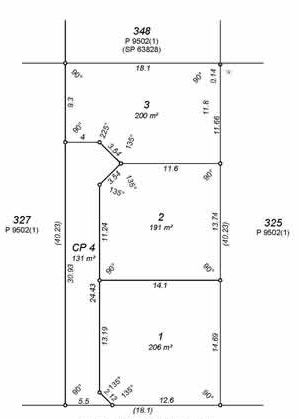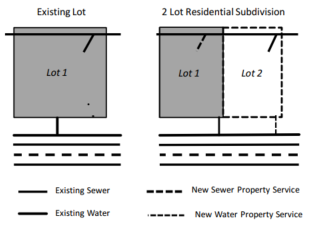Doing your due diligence, and in particular, your development feasibility, is when you make the decision to either proceed with a deal or toss it out. As I often say - just because it's developable, doesn't mean it's profitable. So getting those numbers as close to accurate as you can is a vital part of the process.
Two lines in the feasibility spreadsheet that you need to pay careful attention to are sewer and water connection costs. Why? Because the cost difference between a standard and non-standard connection can be substantial, and you don't want to underestimate the potential cost if it's non-standard.
Which raises the obvious question - what's the difference between standard and non-standard connections?
If I wanted to be a little bit cheeky, I could say that the difference is standard connections are simple and straightforward, and non-standard connections are not. But that would make this blog post very short! And not very helpful. So let's break it down into two easy-to-spot clues.
1. How many lots are you creating?
Really, this is the primary question. If you're working with a single lot site, and either keeping it as a single lot or only creating 1 more, then it's potentially a standard connection. If you're adding more than 1 extra lot to the site - then it's non-standard. That was nice and simple!

2. Where is the existing sewer or water pipe?
This one can be a little more complicated, but as a starting point - if the existing pipe is on your property, then it's a standard connection. On the flip side, if the pipe is on your neighbour's property - yep, you guessed it - that's non-standard.
Now, if we expand that out a little, how about if the pipe is under the nature strip? In that case, the answer isn't necessarily always that it's standard, but most of the time it will be. Exceptions are certainly unusual.
Let's go a bit further - how about if the pipe is on the other side of the road? Uh-oh, hit the buzzer. The other side of the road is definitely crossing, not just the road, but the line into non-standard connection territory. And the costs just went up.
It would be nice if those 2 questions were all you needed to ask to work out if your connection was likely to be standard or non-standard, but you're dealing with service providers, and nothing is ever quite that simple! Still, that's a good start.
Now, assuming that so far it looks like you have a standard connection, there's a few more things you need to check out before you can be reasonably confident you have the right answer.
3. Depth of service
Finding the answer to this one is going to take a little more digging (okay, you can groan). You need to know how deep the sewerage pipes are. Again, service providers may vary a little, but 1.5m deep is a good rule of thumb to work with.
4. Length required
Again, service providers are generally happy to allow up to 10 metres of pipes for your connection, but if you have a long and winding driveway and that pipe is 50 metres away under the nature strip - yep, you guessed it, you're a non-standard connection.
5. Existing services are sufficient to service your new lot/s
This is a bit of a grey area, but one of the big reasons there's a "one extra lot" limit on standard connections is because most of the time the existing services can cope with the extra water or waste involved in the property development.
Sometimes, though, the local provider may decide that the existing service doesn't have sufficient capacity, and will require an upgrade. If there's a bunch of properties nearby that are likely to be developed in the near future (for example after a change in zoning) the provider may also decide an upgrade is required as part of future plans for development, and you can wave goodbye to your standard connection.
For those of you who find it easier to understand things visually, here's an example. If your development looks like the image here...
 Then you've got a fairly good chance your sewerage and water connections will be standard. Otherwise, there's that bad luck buzzer again.
Then you've got a fairly good chance your sewerage and water connections will be standard. Otherwise, there's that bad luck buzzer again.
What Happens Next?
Although I've covered the most common criteria for deciding whether a connection is standard or non-standard, in reality every area has a different service provider, and potentially there are differences between them for certain criteria.
So your next step is to determine who is the service provider for your area, and spend some time thoroughly reading all the information on their website. The good news is that many service providers also include costings, particularly for standard connections, so it's a great way to fill in that line on your feasibility spreadsheet.
Next you need to think about managing the process. With a standard connection, it's relatively straightforward. Basically you put in the application for the connection, pay money, and the service provider makes it happen.
For a non-standard connection, it will almost always be wise to contract a Civil Engineer to manage the process. To give you an idea of what's potentially involved, here's a quick breakdown:
Honestly? Leave it to a Civil Engineer!
Hope that's shed some light on the difference between standard and non-standard connections for water and sewerage! Have fun with your feasibilities.
Two lines in the feasibility spreadsheet that you need to pay careful attention to are sewer and water connection costs. Why? Because the cost difference between a standard and non-standard connection can be substantial, and you don't want to underestimate the potential cost if it's non-standard.
Which raises the obvious question - what's the difference between standard and non-standard connections?
If I wanted to be a little bit cheeky, I could say that the difference is standard connections are simple and straightforward, and non-standard connections are not. But that would make this blog post very short! And not very helpful. So let's break it down into two easy-to-spot clues.
1. How many lots are you creating?
Really, this is the primary question. If you're working with a single lot site, and either keeping it as a single lot or only creating 1 more, then it's potentially a standard connection. If you're adding more than 1 extra lot to the site - then it's non-standard. That was nice and simple!
2. Where is the existing sewer or water pipe?
This one can be a little more complicated, but as a starting point - if the existing pipe is on your property, then it's a standard connection. On the flip side, if the pipe is on your neighbour's property - yep, you guessed it - that's non-standard.
Now, if we expand that out a little, how about if the pipe is under the nature strip? In that case, the answer isn't necessarily always that it's standard, but most of the time it will be. Exceptions are certainly unusual.
Let's go a bit further - how about if the pipe is on the other side of the road? Uh-oh, hit the buzzer. The other side of the road is definitely crossing, not just the road, but the line into non-standard connection territory. And the costs just went up.
It would be nice if those 2 questions were all you needed to ask to work out if your connection was likely to be standard or non-standard, but you're dealing with service providers, and nothing is ever quite that simple! Still, that's a good start.
Now, assuming that so far it looks like you have a standard connection, there's a few more things you need to check out before you can be reasonably confident you have the right answer.
3. Depth of service
Finding the answer to this one is going to take a little more digging (okay, you can groan). You need to know how deep the sewerage pipes are. Again, service providers may vary a little, but 1.5m deep is a good rule of thumb to work with.
4. Length required
Again, service providers are generally happy to allow up to 10 metres of pipes for your connection, but if you have a long and winding driveway and that pipe is 50 metres away under the nature strip - yep, you guessed it, you're a non-standard connection.
5. Existing services are sufficient to service your new lot/s
This is a bit of a grey area, but one of the big reasons there's a "one extra lot" limit on standard connections is because most of the time the existing services can cope with the extra water or waste involved in the property development.
Sometimes, though, the local provider may decide that the existing service doesn't have sufficient capacity, and will require an upgrade. If there's a bunch of properties nearby that are likely to be developed in the near future (for example after a change in zoning) the provider may also decide an upgrade is required as part of future plans for development, and you can wave goodbye to your standard connection.
For those of you who find it easier to understand things visually, here's an example. If your development looks like the image here...
What Happens Next?
Although I've covered the most common criteria for deciding whether a connection is standard or non-standard, in reality every area has a different service provider, and potentially there are differences between them for certain criteria.
So your next step is to determine who is the service provider for your area, and spend some time thoroughly reading all the information on their website. The good news is that many service providers also include costings, particularly for standard connections, so it's a great way to fill in that line on your feasibility spreadsheet.
Next you need to think about managing the process. With a standard connection, it's relatively straightforward. Basically you put in the application for the connection, pay money, and the service provider makes it happen.
For a non-standard connection, it will almost always be wise to contract a Civil Engineer to manage the process. To give you an idea of what's potentially involved, here's a quick breakdown:
- Civil Engineer draws up a conceptual design
- Utility Provider reviews design
- If approved, the Civil Engineer draws up detailed design drawings
- Utility Provider reviews design
- If approved, the Civil Engineer makes an application for Operation Works
- This goes to Council for approval
- The works are put out to tender
- Then you pay money and the work happens
- The works need to be surveyed and mapped as they proceed
- Both the Utility Provider and Council need to inspect the works in progress
- When complete, the works need to be inspected using a camera inside the pipes
- A vacuum test is also conducted to ensure the pipes are air tight
Honestly? Leave it to a Civil Engineer!
Hope that's shed some light on the difference between standard and non-standard connections for water and sewerage! Have fun with your feasibilities.
